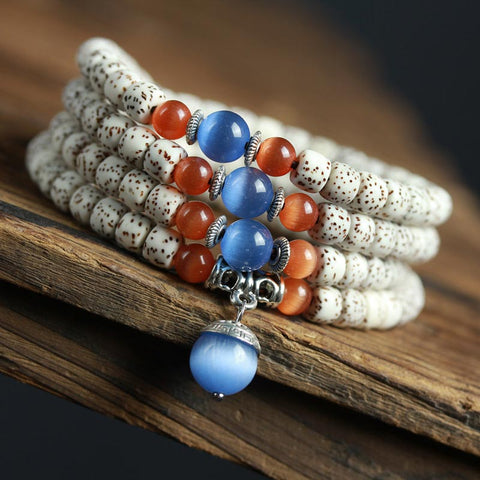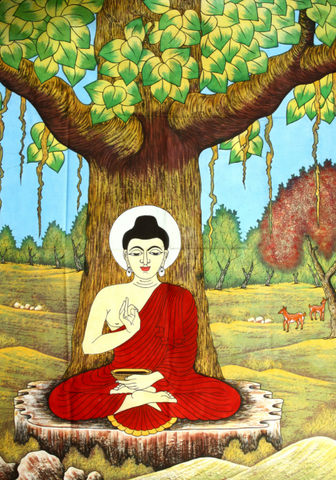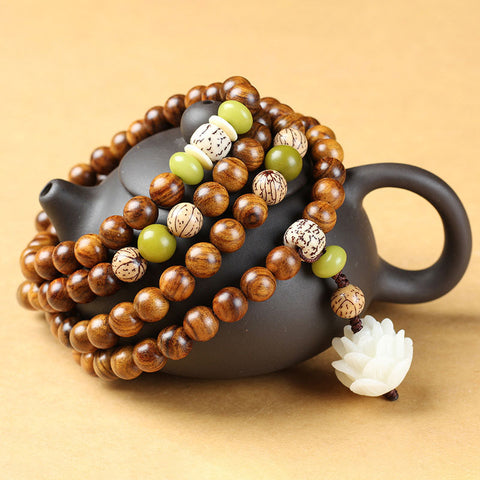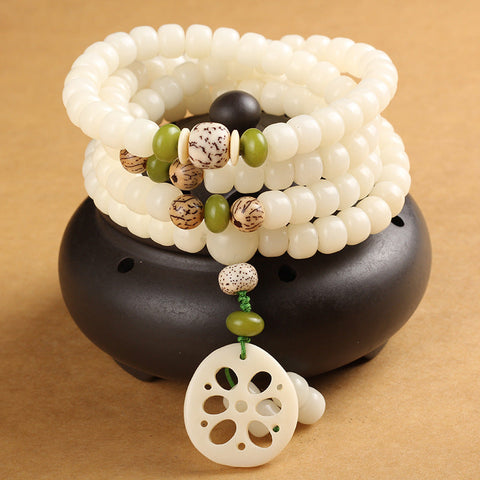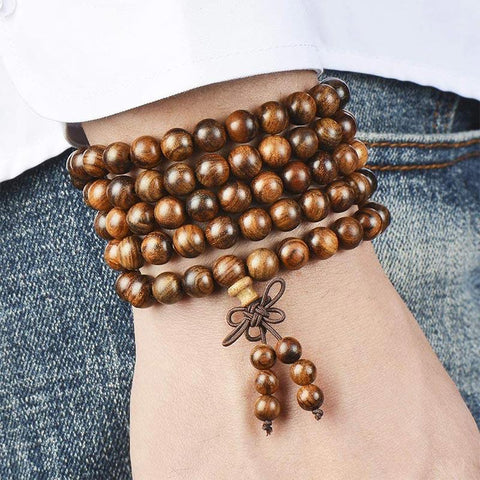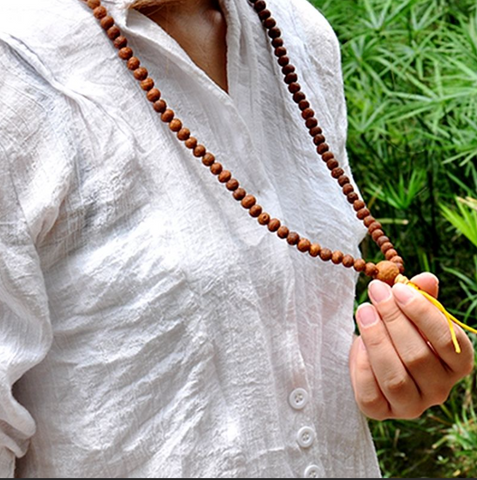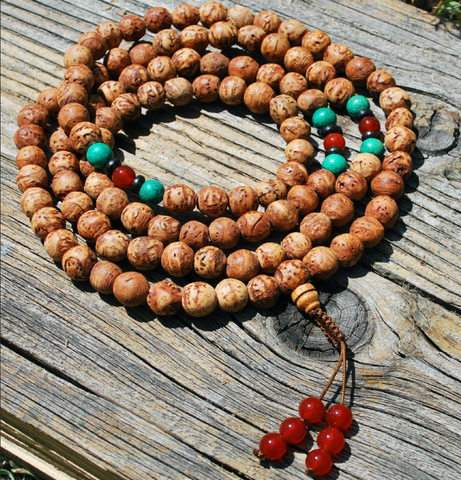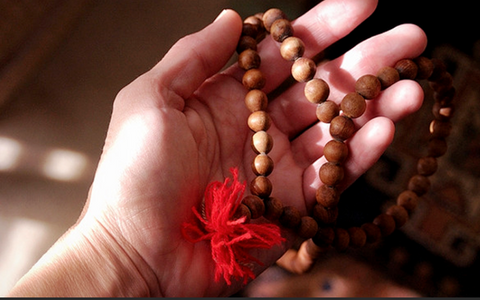What is Bodhi Seed? The Meaning and How To Use
The Buddhist religion has guided the globe toward awareness and hope for a peaceful existence. Buddhism's teachings can help a person down the road of devotion. Mantras and meditation are two such practices that can help you find tranquility.
While there are many ways to recite, Buddhist monks choose to embrace the Bodhi Seed Bead. The term Bodhi Seed Mala derives from the holy fig tree below which Buddha is claimed to have attained enlightenment.
The holy Bodhi Beads are brought to you from Nepal, the hometown of Lord Buddha. The Praying Mala has 108 beads and has an entire length. It includes a tassel with Guru beads on a flexible string. The ancient Bodhi Seed Mala helps you connect to Buddha, the person who established the middle route to enlightenment.
What is Bodhi Seed?
Bodhi seeds, called Mani beads, are a classic Buddhist rosary. The bodhi seed derives from the Holy Tree, which was placed by the Gautama Buddha when he attained enlightenment, as per Buddhist tradition. Mani Pearls are used to count chants during prayers, rites, and meditation.
These lovely small seed rosary beads are a beautiful way to stay connected to your practice. Every bead includes a carved phrase that is made in the form of ancient scrolls and tied on a durable nylon string that bears repeated use.
In Buddhism, the bodhi seeds are revered for their ability to convey the power of meditation along the length. You will be lured into the innermost intentions when you twirl the wristband or run it over the head.
Origin of the Bodhi Seed
Bodhi seeds are commonly worn without being coated, leaving minor bumps or veins visible and solid color. Prince Siddhartha is said to have accomplished enlightenment when meditating below a bodhi tree.
The Bodhi Tree has a special significance. Gautam Buddha was born to a Shakya monarch and attained enlightenment in Bodh Gaya. Sages began wearing Bodhi Mala to experience the tree's holiness later. If you go into the background of its vocabulary, you'll discover that Mala is a Sanskrit term that means "garland."
As Hindu culture began to send flower necklaces to the spiritual teachers, the term was coined. Many people accepted the tradition, and Buddhism was among them. It demonstrates the Buddhist-Hindu relationship. Because Buddhism began in India, it borrowed portions of the Hindu tradition that predominated there, including the tradition of repeating mantras with Japmala.
Bodhi Seed Meaning
Many Buddhists use bodhi seeds during meditation activities to achieve enlightenment. The beads hold unique meaning for all searchers of heavenly wisdom because Buddha attained enlightenment underneath the bodhi tree.
On the spiritual path, every seed gives a sense of tranquility and insight. Each bead contains teaching, since it can be employed for mantra chanting, prayer, and mindfulness. To increase your attention and connection, use bodhi seeds into the conscious practice and spiritual path.
Buddhists and Hindus regard the bodhi seeds mala as sacred. The usage of mala pearls, such as this one, is thought to have been advocated by Gautam Buddha himself for assisting practitioners in paying attention during meditation.
In Buddhism, these are exceedingly significant gifts. They're used to make offerings to the teacher, deities, awakened beings, and other things. This mala is the best religious tool, not just a strand of beads. It may become strong after it is gifted by a monk or a highly realized being.
The Most Popular Bodhi Beads
The seed of Elaeocarpus angustifolius is used to make the most popular Bodhi bead. Elaeocarpus plants are present in China's Hainan, Tibet, and other Asian countries, like Nepal, India, and the Himalayan lowlands. It is known as 'darkish,' which means 'eye of lord Shiv' in the local tongue, maybe the first kind of prayer bead in India.
Sandalwood beads are made from the bark of sandalwood trees, which can be found growing wild in Asia or East India. Sandalwood is regarded as sacred in many cultures and has always been utilized in Buddhist or Hindu rites.
Rosewood is a valuable wood that has been used to construct Buddhist rosary beads for centuries. Rosewood beads are thought to eliminate negativity and evil feelings when meditated with. Its dark, striking color is linked with stability and protection. They safeguard the wearer from negative energy, provide safety, and promote calm and prosperity. During mindfulness, the naturally wrinkled and pitted texture gives a distinct feeling for the fingertips, aiding in grounding you at the moment.
Multiple Uses in Bodhi Seed
"Bodhi" denotes awakened in Sanskrit; hence the bodhi seed denotes "enlightened seed." Bodhi is a Buddhist phrase that refers to a Buddha's realization of the actual essence of things. Rudraksha is the fruit of a Himalayan tree that blooms at a particular elevation.
The seeds are reported to have many energetic properties, including increasing clarity and awareness, calming the nervous system, aiding in mind-calming, and releasing negative thoughts. The bead itself is solid and thick.
Mala beads are often made out of wood, seeds, or gems. Some of the available choices are as follows:
· Rudraksha
· Bodhi Seeds
· Antique Bodhi Seeds
Clapping mantras is a pretty simple process. Say a chant of your preference, or any prayer or desire, with every bead. Om, harmony, or love are some examples of mantras. Humming, murmuring, or even plainly speaking are all possibilities for the voice.
Repeating these chants will provide you with good forward energy and a great mental focus. It's impossible to concentrate on the first path. There will be stray ideas that will divert attention away from the task at hand.
Bodhi Seed With Buddhism
The Prayer Mala should have 108 beads to symbolize impurities. They are worn by Monks and nuns as a symbol of purity, indicating that they have vanquished impurities. Therefore, prayer stones with a bead size varying from 1 to 2 of 108 to 104 are available. The mantras spoken with the meditation rosary beads help relax the soul, allowing you to take the next step toward awareness.
With continued use, the Bodhi Seed Mala strands become more lovely. It represents the soul's purity. The Bodhi mala is roughly 10 - 12 mm in size. The seeds of the bodhi tree are dried, perforated for holes, and threaded into malas.
For nearly a millennium, the method has remained unchanged. The quality is strong, long-lasting, and has a strong odor. It transforms into a lovely rusty bead necklace after a long period of use. Because they are too large to wear on the hand, the Bodhi mala is worn across the neck.
Types of Bodhi Beads
Counter and spacer beads are included in this full-length mala. The Bodhi Mala is divided into four portions, each with twenty-seven pieces. Moreover, the Bodhi mala is available in several lengths, including 54, 27, or 21 beads. Mala bracelets, which comprise 18 beads, are available. Flexible cords are used in several malas.
Many have movable cords to adjust, whereas these stretchy strings are for the hand. There are different types available having different Bodhi seed mala meaning.
Wrist Malas are made up of 27 beads plus a head bead. The wrist beads can be counted four times for a total of 108. There are no ties between the gems on wrist malas because they are strung on an elastic string. The perimeter of the mala is used to take measurements.
Bodhi Seed Meditation
These are the best for counting breaths or chant rounds during meditation. The conclusion and start of every 108-bead count are indicated by a top bead on neck malas. In Buddhist culture, the amount of beads represents the 108 earthly sins, while in Hindu belief, it represents a multiple of '9.' In many other faiths, this figure is likewise significant. Each sort of bead has a distinct meaning.
A regular 108-bead mala has 108 beads. As previously stated, the number indicates the universe's divine center coordinates. A tassel is attached at the tip of the master beads, which are the biggest in the bodhi Mala.

The holy link between the pupil and the instructor is symbolized by this. It is recommended that you return after attaining the guru bead after meditation. This action shows that you haven't trodden on the teacher's toes and handed it in for practice.
Some of the consequences are feelings of calm and increased attention are the advantages of meditation. Meditation has been linked to a slew of medical and mental advantages, according to research. You can benefit from this exercise no matter what kind of life you have.
How to Cleanse Bodhi Seed Mala Beads
Sunlight: Keeping the mala beads under the sunlight is the best method to wash them (prevent direct exposure). The energy of the sun is pleasant and healing. Soak the mala in the light for several hours (particularly early morning) to purify it.
Moonlight: You may use the moon's tremendous energy to purify the mala. The best time to cleanse the mala is during a full and new moon. You may quickly re-energize the mala by placing it on the sill.
Using Inner Power: You can use the inner power to clean the mala strands, which is as effective as any other approach. All you have to do is lay the mala on a dry towel next to you. Shut your eyes and imagine a dazzling, bright flash surrounding the bead in a meditative position. Use this force to clean the mala, then come to a complete stop when you're ready. Saltwater and rock salt mixed with water are other options to cleanse the mala.
How to Care for Your Bodhi Seed Mala
Kindly do not use the mala for lengthy periods wrapped over the wrist, as it can damage it. If not in use, place the mala in the bag included.
For bowing practice, only use Bodhi beads, which can be preserved by putting in small quantities of olive oil. When doing any movement-based activity, wearing the mala beads can cause them to come off or get snagged on something, causing them to break.
Don't submerge the mala in water, specifically if it's made of seed beads. Wear outside of the toilet, bathtub, or pool. Based on the source and batch, many gems have been boosted color, dyed, or polished. Do not expose it to extreme sweat or sun.
Avoid exposing the mala strands to direct sun since the color of particular stones can degrade with time. Your mala beads must be used, worn, and stored with love, kindness, and attention. Mala beads must be handled with reverence and respect as holy spiritual items. Also, you must avoid keeping the malas on the dirty floor. Designers suggest keeping malas in a bag or wooden box.
What Should We Do If The Bodhi Seed Mala Breaks?
When the mala splits, it's a good gesture to say goodbye to it by clasping your hands together and bowing your head. Do that with respect, as though you're presenting a sacrifice and expressing your gratitude. Throwing the damaged mala into a closet, thinking you'll "get to it soon" is not a good idea. You don't want to be carrying about the vibe of a shattered mala.
Recall how ecstatic you were when you just got the mala? It was the start of a new engagement, so maintain that energy while you finish and terminate this one. Pull the mala down and scatter the beads over your landscape or home. Repurpose the beads into something new. It should be buried. Do everything you can to be grateful for what you have.
Conclusion
That is where you may let your imagination run wild. Finding a suitable mix of seeds or gemstones, goals, and mantras can improve your spiritual path. The structure of the mala beads is a source of energy. Each item can provide you with energy and healing lessons.
These mystical reminders will energize the body and brain. That's why choosing the beads, stones, and chants to set your goals is so beneficial. This phase will assist you in improving your practices and goals. Meditation is the best approach to reduce stress and improve health.
Whenever you wear these malas while relaxing, it is said that the blood pressure will be controlled, and the heart rate will be reduced. That, in turn, aids in the development of well-rounded awareness.





